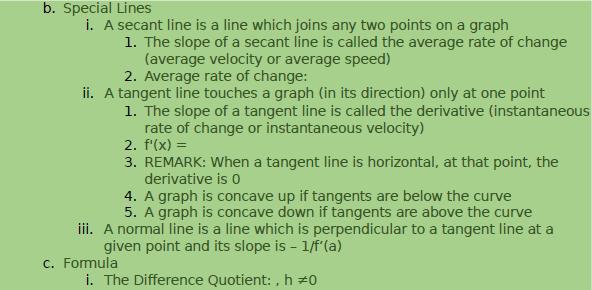Answered step by step
Verified Expert Solution
Question
1 Approved Answer
= II. Linear Functions a. Polynomials of degree 1 i. Their equations can be written in 3 forms: 1. Point-slope form: y-y = m(x


= II. Linear Functions a. Polynomials of degree 1 i. Their equations can be written in 3 forms: 1. Point-slope form: y-y = m(x - x) 2. Slope-intercept form: y = mx + b = 3. General form: Ax + By = C, where A and B and C are integers a. i.e., 3x-5y 11 (written implicitly, x and y are within the formula, slope is not obvious) ii. If L1 || L, then m = me (same slopes) iii. If L LL2, then m = -1/m2 b. Special Lines i. A secant line is a line which joins any two points on a graph 1. The slope of a secant line is called the average rate of change (average velocity or average speed) 2. Average rate of change: ii. A tangent line touches a graph (in its direction) only at one point 1. The slope of a tangent line is called the derivative (instantaneous rate of change or instantaneous velocity) 2. f'(x) = 3. REMARK: When a tangent line is horizontal, at that point, the derivative is 0 4. A graph is concave up if tangents are below the curve 5. A graph is concave down if tangents are above the curve iii. A normal line is a line which is perpendicular to a tangent line at a given point and its slope is - 1/f'(a) c. Formula i. The Difference Quotient:, h #0
Step by Step Solution
There are 3 Steps involved in it
Step: 1

Get Instant Access to Expert-Tailored Solutions
See step-by-step solutions with expert insights and AI powered tools for academic success
Step: 2

Step: 3

Ace Your Homework with AI
Get the answers you need in no time with our AI-driven, step-by-step assistance
Get Started


